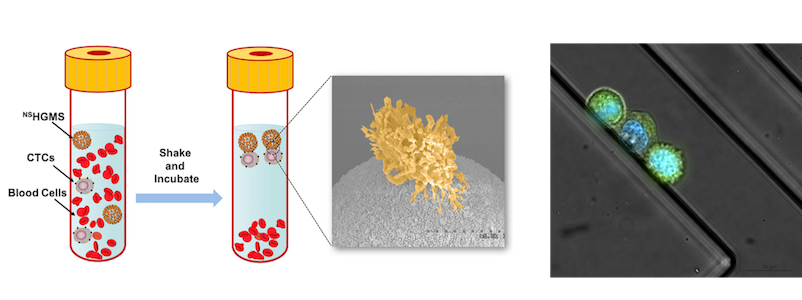Research

Capture and release of circulating tumor cells (CTCs) using biodegradable nanofilms
The selective isolation and purification of circulating tumor cells (CTCs) in whole blood is an important challenge for both clinical medicine and biological research. Many of the current techniques to perform this task place the isolated cells under excessive stresses that reduce cell viability and can interfere with cellular processes leading to loss of phenotype and subsequent loss of valuable information about the isolated cell. Layer-by-layer (LbL) is a robust method for creating thin films from a broad range of materials through complementary interactions for use in many various applications. By constructing an LbL film capable of selectively isolating cells from bulk fluid and which can be degraded on command, we are able to gently isolate cells and recover them with minimal impact on the cells. This provides a capability to investigate the properties of specific cell subpopulations with an accuracy that has been difficult to achieve by other means.

Selected publications:
- Z. Dong, D. Yu, Q. Liu, Z. Ding, V. J. Lyons, R. K. Bright, D. Pappas, X. Liu, and W. Li*. Enhanced Capture and Release of Circulating Tumor Cells Using Hollow Glass Microspheres with Nanostructured Surface. Nanoscale , 2018, 10.1039/C8NR04434A.
- Z. Dong, C. C. Ahrens, D. Yu, Z. Ding, H. T. Lim, and W. Li*. Cell Isolation and Recovery Using Hollow Glass Microspheres Coated with Nanolayered Films for Applications in Resource-Limited Settings. ACS Applied Materials & Interfaces. , 2017, 9, 15265- 15273.
- M-H. Park, E. Reategui, W. Li, S. N. Tessier, K. H. K. Wong, A. Jensen, V. Thapar, D. Ting, M. Toner, S. L. Stott, P. T. Hammond. Enhanced Isolation and Release of Circulating Tumor Cells Using Nanoparticle Binding and Ligand Exchange in a Microfluidic Chip. J. Am. Chem. Soc., 2017, 139, 2741-2749.
- W. Li, E. Reategui, M-H. Park, S. A. Castleberry, J. Z. Deng, B. Hsu, S. Mayner, A. Jensen, L. V. Sequist, S. Maheswaran, D. A. Haber, M. Toner, S. L. Stott. P. T. Hammond. Biodegradable Nano-Films for Capture and Non-invasive Release of Circulating Tumor Cells. Biomaterials, 2015, 65, 93-102.
High throughput assembly and screening of layer-by-layer (LbL) film libraries
Layer-by-layer (LbL) assembly is a powerful tool with increasing real world applications in energy, biomaterials, active surfaces, and membranes; however, the current state of art requires individual sample construction using large quantities of material. We developed a technique using capillary force within a microfluidic device for high-throughput assembly of LbL libraries. This method significantly reduces material waste, improves quality control, and expands the potential applications of LbL into new research spaces. Recent study suggested that the use of LbL films can achieve designed co-delivery of a anticancer drug with a synergistic siRNA or other small molecules, which could lead to significant tumor reduction in the cancers that are nonresponsive to treatment with common chemotherapy drugs. In order to further explore this concept and overcome practical challenges, we will apply this high throughput assembly platform to create large numbers of LbL film libraries and screen the effect of drug co-releasing on cancer cell progression. Our approach provides a cost effective platform to test a broad range of controlled multidrug therapies for aggressive and resistant cancers.

Selected publications:
- Z. Dong, L. Tang, C. C. Ahrens, V. Cao, Z. Ding, S. A. Castleberry, J. T. Yan, and W. Li*. A benchtop capillary flow layer-by-layer (CF-LbL) platform for rapid assembly and screening of biodegradable nanolayered films. Lab on a Chip, 2016, 23, 4601-4611.
- S. A. Castleberry,* W. Li,* D. Deng, S. Mayner, P. T. Hammond. Capillary Flow Layer-by-Layer: A Microfluidic Platform for the High Throughput Assembly and Screening of Nanolayered Film Libraries. ACS Nano, 2014, 8, 6580-6589.
- Z. Wang, D. Voicu, L. Tang, W. Li,* E. Kumacheva.* Microfluidic Studies of Polymer Absorption in Flow. Lab on a Chip, 2015, 15, 2110-2116.
Biomimetic 3D cell microenvironment
Current in vitro cell culture removes cells from their native tissue context, which can disrupt these interactions and induce changes in gene expression and cellular phenotype. In order to address these limitations, we recently built a biomimetic cell microenvironment by culturing cells in direct contact with 'synthetic neighbors', cell-sized soft polymer microbeads that were modified with cell surface ligands and tissue-specific ECMs. This 3D microenvironment was able to promote native cell-cell and cell-ECM interactions. We will optimize design principles of 3D cell culture platform in order to further enhance survive and function of pancreatic β-cells in vitro. We will exploit recent advances in fluorescence resonance energy transfer (FRET) technology and thin film fabrication to create an in situ FRET insulin sensor on microbeads for use in 3D cell culture. We will construct 3D cell culture systems integrated with multiple compartments that not only mimics the in vivo cell organization but also has the ability to release key molecular regulators that influence cell development and gene expression.

Selected publications:
- C. C. Ahrens, Z. Dong, and W. Li*. Engineering Cell Aggregates through Incorporated Polymeric Microparticles. Acta Biomaterialia, 2017, 15, 64-81.
- W. Li, S. Lee, M. Ma, S.M. Kim, P. Guye, J.R. Pancoast, D. G. Anderson, R. Weiss, R. T. Lee, P. T. Hammond. Microbead-based Biomimetic Synthetic Neighbors Enhance Survival and Function of Rat Pancreatic β-cells. Scientific Reports, 2013, 3, 2863.
The Li Lab
-
Address
Texas Tech University, PO Box 43121, Lubbock, TX, 79409-3121 -
Phone
806.834.2209 -
Email
wei.li@ttu.edu
